The Cone of Shame… the Lamp Shade… the Pet Radar Dish… such is the dreaded fate of post-surgery animals everywhere. If your dog is not a huge fan of the Elizabethan Collar or E-collar for short, you’re not alone. At TopDog Health, we hear this comment all day long.
For loving pet parents, it can be difficult and emotionally exhausting enough to watch your dog endure a surgical procedure or an injury. To then take them home from the veterinarian wearing an E-collar only adds more stress to the situation, and keeping it on during the healing process can be as frustrating for you as it is for your dog. We encounter countless pet owners that feel terrible when their dog is made to wear something they despise.
So, you may be wondering, “What can I do about it, if anything?” Does your dog have to wear their E-collar? What can you do to make it easier on them? Are there any alternatives? We’re here to provide some clarity and help you find the best solution for you and your dog.
E-Collar Basics
What Is an E-Collar?
An E-collar is a plastic cone placed around the head to prevent an animal from licking at a surgery site, wound, or dressing. Just a little fun fact, the person who patented the E-collar in 1962 was named F.L. Johnson, and there is no record anywhere as to whether or not they were a veterinarian. It was quite creatively named because it mimics the shape of the fashion choice of Queen Elizabeth the First from the 16th century, who famously wore what was then referred to as a ruff collar of lace around her neck, which later became known as an Elizabethan Collar. Quite the fashion statement at the time.
Why Does My Dog Need an E-Collar?
Following surgery or injury, E-collars are necessary for dogs because it is their instinct to lick or nurse the surgical incision or wound – this is simply what your dog believes they need to do to care for their injury. However, licking their wound or chewing on their skin could cause your dog to inadvertently rip out their stitches, which could then reopen the incision or wound and introduce bacteria into it, which could cause a secondary infection. In essence, it interrupts the healing process.
But, Does My Dog Need an E-Collar?
If your veterinarian has recommended an E-collar for your pet, the short answer, unfortunately, is yes. Luckily, the collar only needs to be kept on the dog 7-10 days after surgery, which allows enough time for primary healing to occur. in the grand scheme of things, this is not that long.
The stricter you are with the E-collar, the quicker your dog will get used to it. Keep in mind that dogs don’t hold grudges. We promise, even if your dog seems to hate the cone of shame, they won’t hold it against you in the long run– so stay strong. Plus, keep in mind that if your dog were to get at the incision and either infect or re-open it, the potential damage would cause more harm to your dog and ultimately prolong their discomfort (not to mention that an extra trip to the veterinarian is going to cost you more money).
With that said, if your dog absolutely cannot stand the E-collar, there are certain alternatives that they may find more comfortable but that still achieve the same purpose (more on that below). If your dog is having trouble with their E-collar, first try the following tips that can make their life with the lampshade a little easier.
E-Collar Tips and Tricks
How Can I Stop My Dog from Banging into Things When Wearing the E-Collar?
The good news here is that most dogs will get used to the E-collar after a few hours (especially if you are strict with keeping it on). The collar restricts your dog’s vision from the sides and behind and initially causes difficulty for many dogs when they walk in tight or narrow spaces. Banging into objects they can’t see (especially ones that may fall over and make sudden noises) can be frightening for your pup.
You can ease their transition by initially keeping your dog in a confined space where there are no small objects such as stools, chairs, and tables which would move if knocked. Think of a laundry room or a bedroom with smaller furniture removed. Once your dog is more comfortable in the collar, you can let them move freely about the house.
Can My Dog Eat and Drink While Wearing the E-Collar?
Yes, a properly sized and adjusted E-collar should allow your dog to eat and drink without any problem. Your dog can also pee, poop, and sleep with the collar on. (Quick tip: you can ensure your dog’s collar is not too tight by seeing if you can easily place two fingers between the edge of the collar and their coat. If it feels too tight and/or is irritating the skin around their neck, you may need a different fit or size).
If your dog is having trouble eating or drinking with the collar on, try offering their food and water on a shallow plate (instead of their usual dish which is deeper). You can also try elevating the dish, which may make it easier to access. If none of these tips are working and you feel you have to remove the E-collar to let your dog eat and drink, be sure to supervise them and replace it as soon as they’re finished. Better safe than sorry.
Do I Need to Clean the E-Collar?
Yes, it’s important to keep the E-collar clean. You can wipe the collar with a damp cloth daily, or if your dog won’t let you do this, remove it and clean it under the sink (just be sure to supervise your dog closely while the collar is removed).
Can My Dog Go Outside by Themselves with the E-Collar On?
This is typically not recommended, as your dog has an increased risk of getting tangled in plants or shrubbery, which could result in injury or simply frighten them. Most dogs wearing an E-collar do well on a short leash – try putting one on them when they go outside to use the restroom to ensure they stay safe.
E-Collar Alternatives
So what if you’ve tried all the tips and tricks above and your dog still cannot tolerate the traditional plastic E-collar? Luckily for you (and your dog), there are several alternatives on the market. Take a look at some of our favorite options, plus their pros and cons. (Hint: there is a summarized cheat sheet of the alternatives at the end of this article).
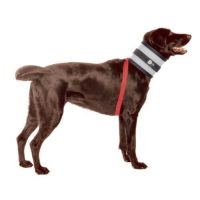 BiteNot Pet Collar ($22-$40)
BiteNot Pet Collar ($22-$40)
The BiteNot Collar is a collar made of flexible plastic and foam that fits like a neck brace and includes a harness strap. Since it does not limit vision, it’s a great alternative for dogs that are frightened by bumping into things when wearing the E-collar. However, it does not protect your dog from reaching their eyes, ears, feet, or lower leg, so do not use the BiteNot if your dog’s injury is in any of these areas.
Pros:
- Does not block vision
- Available in 7 sizes
- Machine washable
- Won’t scratch furniture
Cons:
- Does not protect the eyes, ears, feet, or lower leg
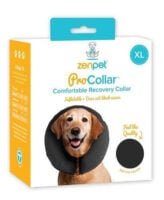 Procollar ($20-$25)
Procollar ($20-$25)
The Procollar looks and fits like an inflatable neck pillow for your dog (like what you wear on an airplane). It does not block your pet’s vision and is a more comfortable option, but know that some pets can remove it, and it can also pop if your pup is overly rambunctious or brushes against something like the sharp corner of a table.
Pros:
- Does not block vision
- Available in 7 sizes
- Lightweight
- Won’t scratch furniture
Cons:
- Some dogs can remove it
- It can pop
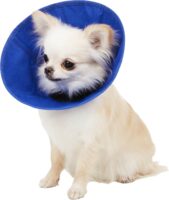 KONG EZ Soft Collar ($7-$9)
KONG EZ Soft Collar ($7-$9)
The KONG EZ Soft Collar has the same lampshade shape as the traditional E-collar but is made of soft, pliant material that can make it a less stressful option for your pup. However, it’s only available in 2 sizes (small and extra small) so isn’t an option if you have a bigger dog.
Pros:
- Flexible cone shape
- Won’t scratch furniture
- Machine washable
- Includes drawstring to tighten quickly
Cons
- Impedes vision
- Only comes in sizes for small dogs
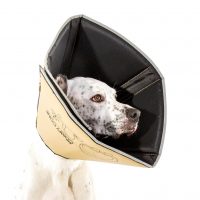 Comfy Cone ($15-$25)
Comfy Cone ($15-$25)
The Comfy Cone also has the same shape as the traditional E-collar but is made of soft material that can be folded back when your dog is eating or drinking. It attaches to your dog’s regular collar which helps prevent it from being pulled off and also has a reflective binding to help protect you and your pet while going outside at night for walks and bathroom breaks. It comes in a wide range of sizes, but can be heavy for smaller dogs.
Pros:
- Flexible cone shape
- Attaches to your dog’s regular collar
- Reflective fabric for safety
- Won’t scratch furniture
- Available in 8 sizes
Cons:
- Impedes vision
- Can be heavy for small dogs
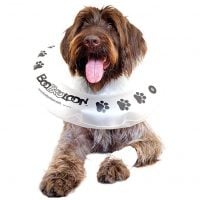 BooBooLoon ($13-$70)
BooBooLoon ($13-$70)
This looks like an inflatable life buoy that fits around your dog’s neck. It is lightweight and made of a clear material. It is also the predecessor to the KONG EZ Cushion and is no longer in production, so can be found at extremely discounted rates. The downside is that some dogs can still reach the problem areas while wearing it, and it can also pop.
Pros:
- Does not impede vision
- Lightweight and clear material
- Won’t scratch furniture
- Discounted prices available
Cons
- Some dogs can reach problem areas
- It can pop
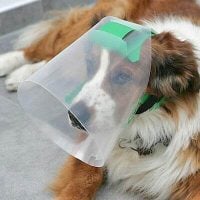 Optivisor/Novaguard ($21-$54)
Optivisor/Novaguard ($21-$54)
The Optivisor/Novaguard fits your dog like a face mask (think of what a welder would wear to protect their face from sparks), and has a chin strap to assist with giving medication. It also has a custom fit, as you can cut the plastic to fit your dog’s face. However, it does not work for small dogs.
Pros:
- Does not impede vision
- Chinstrap for giving medication
- Custom-fit
Cons:
- Doesn’t fit small dogs
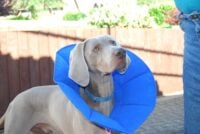 TCOA Soft E-Fabric Collar ($8-$12)
TCOA Soft E-Fabric Collar ($8-$12)
The Company of Animals Soft E-Fabric Collar is another option that’s shaped like the traditional E-collar but is soft and comfortable. It ties together with a double knot, however, some animals can remove it. While it comes in 5 sizes, the product is no longer in production, so some sizes may be difficult to find.
Pros:
- Flexible cone shape
- Lightweight
- Won’t scratch furniture
- Ties together with a double knot
Cons:
- Some animals can remove it
- Discontinued (some sizes may be hard to find)
When all is said and done, here’s the bottom line on the E-collar. Some dogs don’t mind it at all. Then some go crazy to get it off. At the same time, there are some dogs that, even without a collar, would not lick or bite their incision. And of course, others will do anything and everything to get at the incision.
The purpose of the E-collar is to keep your dog’s healing process as quick and uncomplicated as possible, so if your dog can tolerate the cone, then absolutely leave it on and try not to “feel bad” because it is only temporary and for their good. If your dog hates the E-collar, try one of the above alternatives to hopefully make them a little more comfortable while still keeping them on track with their healing.
It may take some trial and error to make the E-collar work or to find the best alternative for your pup, but it’s worth it for their health and happiness. Wishing your dog a safe and speedy recovery!


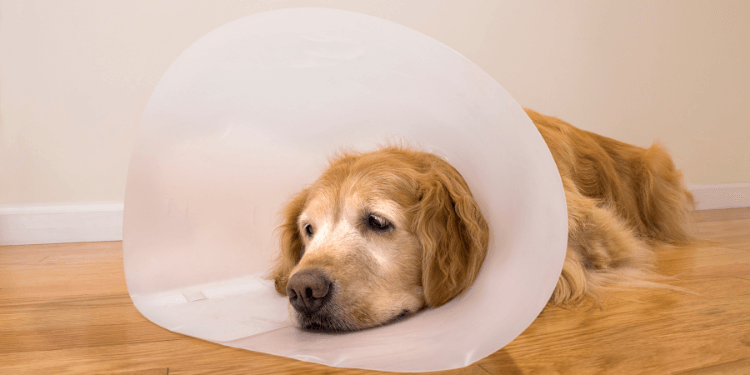
 BiteNot Pet Collar ($22-$40)
BiteNot Pet Collar ($22-$40) Procollar ($20-$25)
Procollar ($20-$25) KONG EZ Soft Collar ($7-$9)
KONG EZ Soft Collar ($7-$9) Comfy Cone ($15-$25)
Comfy Cone ($15-$25) BooBooLoon ($13-$70)
BooBooLoon ($13-$70) Optivisor/Novaguard ($21-$54)
Optivisor/Novaguard ($21-$54) TCOA Soft E-Fabric Collar ($8-$12)
TCOA Soft E-Fabric Collar ($8-$12)







